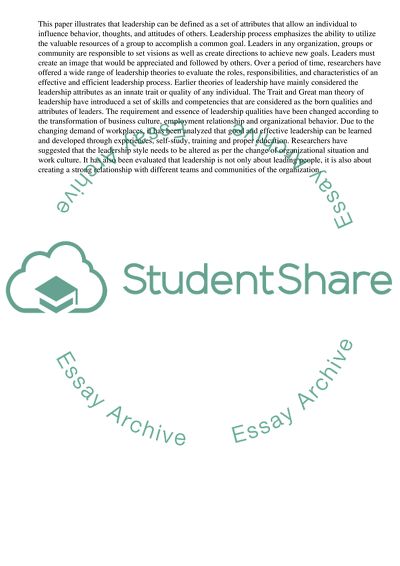Cite this document
(“Leadership Theories and Their Usefulness Essay Example | Topics and Well Written Essays - 3750 words - 1”, n.d.)
Leadership Theories and Their Usefulness Essay Example | Topics and Well Written Essays - 3750 words - 1. Retrieved from https://studentshare.org/management/1685771-critically-evaluate-three-leadership-theories-and-their-usefulness-as-a-tool-to-assess-and-enhance-your-leadership-skills-and-the-challenges-you-may-need-to-overcome-to-become-an-effective-leader-in-future
Leadership Theories and Their Usefulness Essay Example | Topics and Well Written Essays - 3750 words - 1. Retrieved from https://studentshare.org/management/1685771-critically-evaluate-three-leadership-theories-and-their-usefulness-as-a-tool-to-assess-and-enhance-your-leadership-skills-and-the-challenges-you-may-need-to-overcome-to-become-an-effective-leader-in-future
(Leadership Theories and Their Usefulness Essay Example | Topics and Well Written Essays - 3750 Words - 1)
Leadership Theories and Their Usefulness Essay Example | Topics and Well Written Essays - 3750 Words - 1. https://studentshare.org/management/1685771-critically-evaluate-three-leadership-theories-and-their-usefulness-as-a-tool-to-assess-and-enhance-your-leadership-skills-and-the-challenges-you-may-need-to-overcome-to-become-an-effective-leader-in-future.
Leadership Theories and Their Usefulness Essay Example | Topics and Well Written Essays - 3750 Words - 1. https://studentshare.org/management/1685771-critically-evaluate-three-leadership-theories-and-their-usefulness-as-a-tool-to-assess-and-enhance-your-leadership-skills-and-the-challenges-you-may-need-to-overcome-to-become-an-effective-leader-in-future.
“Leadership Theories and Their Usefulness Essay Example | Topics and Well Written Essays - 3750 Words - 1”, n.d. https://studentshare.org/management/1685771-critically-evaluate-three-leadership-theories-and-their-usefulness-as-a-tool-to-assess-and-enhance-your-leadership-skills-and-the-challenges-you-may-need-to-overcome-to-become-an-effective-leader-in-future.


